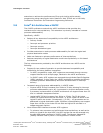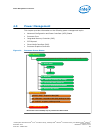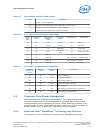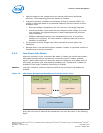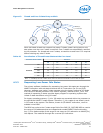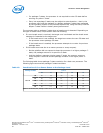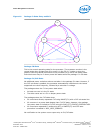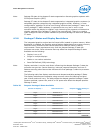
Core C6 State
Individual threads of a core can enter the C6 state by initiating a P_LVL3 I/O read or
an MWAIT(C6) instruction. Before entering core C6 state, the core will save its
architectural state to a dedicated SRAM. Once complete, a core will have its voltage
reduced to zero volts. During exit, the core is powered on and its architectural state is
restored.
Core C7 State
Individual threads of a core can enter the C7 state by initiating a P_LVL4 I/O read to
the P_BLK or by an MWAIT(C7) instruction. The core C7 state exhibits the same
behavior as the core C6 state.
Note: C7 state may not be available on all SKUs.
C-State Auto-Demotion
In general, deeper C-states, such as C6 state, have long latencies and have higher
energy entry/exit costs. The resulting performance and energy penalties become
significant when the entry/exit frequency of a deeper C-state is high. Therefore,
incorrect or inefficient usage of deeper C-states have a negative impact on idle power.
To increase residency and improve idle power in deeper C-states, the processor
supports C-state auto-demotion.
There are two C-state auto-demotion options:
• C7/C6 to C3 state
• C7/C6/C3 To C1 state
The decision to demote a core from C6/C7 to C3 or C3/C6/C7 to C1 state is based on
each core’s immediate residency history and interrupt rate . If the interrupt rate
experienced on a core is high and the residence in a deep C-state between such
interrupts is low, the core can be demoted to a C3 or C1 state. A higher interrupt
pattern is required to demote a core to C1 state as compared to C3 state.
This feature is disabled by default. BIOS must enable it in the
PMG_CST_CONFIG_CONTROL register. The auto-demotion policy is also configured by
this register.
Package C-States
The processor supports C0, C1/C1E, C3, C6, and C7 (on some SKUs) power states.
The following is a summary of the general rules for package C-state entry. These
apply to all package C-states, unless specified otherwise:
• A package C-state request is determined by the lowest numerical core C-state
amongst all cores.
• A package C-state is automatically resolved by the processor depending on the
core idle power states and the status of the platform components.
— Each core can be at a lower idle power state than the package if the platform
does not grant the processor permission to enter a requested package C-state.
— The platform may allow additional power savings to be realized in the
processor.
4.2.5
Power Management—Processor
Desktop 4th Generation Intel
®
Core
™
Processor Family, Desktop Intel
®
Pentium
®
Processor Family, and Desktop Intel
®
Celeron
®
Processor Family
December 2013 Datasheet – Volume 1 of 2
Order No.: 328897-004 55



